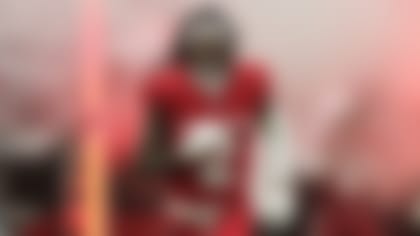When scanning through some of the age old creeds of the fantasy community I often find myself thinking, "We can do better". I get it. There are certain ideals we've held dear for many years, such is true in many walks of life. It's easier to default to the standards of tradition than to accept the winds of change.
However, just as in any field of study, those of us in the fantasy community must be willing to challenge our assumptions when information and data demands it. One such analysis that needs an overhaul is how we think about the long held concepts of the "handcuff".
For years, fantasy analysts recommended that you take an insurance policy on your top running backs by selecting their backup before you leave your fantasy draft. There's an "it's just what you have to do" tone to it. But should it be such a naturally assumed requirement? We're going to turn over every rock on our way to finding out, and come up with an actionable piece of advice in approaching the running back handcuff.
The recent history of the handcuff
The first step in deciding whether the running back handcuff is a worthwhile approach is to look at recent examples of the concept unfolding. NumberFire's editor-in-chief and noted data-miner, JJ Zachariason, recently examined what running back busts selected in the top-10 picks of fantasy drafts over the last six years looked like. In Zachariason's findings, nine of the 60 backs from the sample busted at least partially due to injury.
Right away, that stands out. Draft philosophies such as the zero RB, do the opposite and upside down drafting grew in popularity over recent seasons on the back of the concept of running back volatility. While it's true, of the major fantasy positions, running backs are generally more susceptible to turnover than the others. However, only 15 percent of the top 10 players at the position over the last six years missed a stretch of games, and disappointed their fantasy owners.
It's fair to question whether spending fantasy draft capital on another player on the 15 percent odds that your first round pick goes down is worthwhile.
The second layer in this historical rewind is examining how the backups to the injured running backs were used in their stead. For these purposes, I also took the liberty of lumping Adrian Peterson's 15 game absences in with the injured nine. Different circumstances, but the results of handcuffs filling in for a starter on a long absences had some utility for this study.
GMs indicates the number of games the starter missed. AVG FPs are the average 12-team standard fantasy points scored in games the starter did not play. Carry % is the percentage of the team's carries the running back handled in games the starter missed.
First, let's look at the usage of the primary backups. The 10 "handcuff" players collectively averaged 53 percent of their team's carries during the games the starter missed. Workhorse running backs, in backfields with clarity, typically average somewhere between 60 to the low 70's range in terms of percent of their team's carries. Only two of these handcuff running backs, Marcel Reece in 2012 and Michael Bush in 2011, assumed a workhorse level carry rate.
There are certain cases where a handcuff fulfills the dreams of fantasy owners hoping for their running back to slide right into an absent starter's workload. However, more often than not, that backup will simply be the leading man in a committee or "all hands" approach to filling in for the starter.
Now let's see how these handcuffs performed in their shot to replace a starter. As nice as opportunity is, the bottom line for fantasy is scoring points. The results are a mixed bag. The best replacements were Bush and Reece for Darren McFadden in 2011 and 2012, respectively, and Bobby Rainey for Doug Martin in 2013. The other double-digit point scorers were Ben Tate filling in for Arian Foster in 2013, and Matt Asiata in 2014. Of course, anyone who tried to use Asiata last season knows that 10.6 points came in highly fluctuating spurts, with his value solely dictated by touchdowns.
Let's put these performances in context by looking at the point output of replacement level running backs over the last five years. Refer to the chart on the right for the average fantasy points scored by replacement level RB1s, RB2s and RB3s from 2010 to 2014.
The only running back handcuffs to return RB1 value in the absence of a starter were Bush in 2011 and Reece in 2012. How about that, Raiders fans?
Most of these running backs returned a wide variety of RB2 production. Some were wildly inconsistent game to game, like Asiata and Felix Jones, while others were barely above replacement level, like Jonathan Stewart and 2013 Bobby Rainey. Given the wide range of outcomes those players presented on a weekly basis, it's hard to categorize that group as clear-cut usable fantasy assets. Tate in 2012 was probably the best example of a handcuff working out to give fantasy owners steady, usable RB2 production.
There were two examples of pure dumpster fires in the sample. When Jamaal Charles missed almost the entire 2011 season, and Maurice Jones-Drew went down for nine games in 2012, their handcuffs failed to deliver. Thomas Jones, the more regarded veteran, broke down and lost carries to Jackie Battle. The latter just barely performed at a rate expected for a replacement level RB3. He was not a usable fantasy asset. Rashad Jennings was a highly-regarded player even back in 2011. Fantasy owners were so excited about handcuffing him with Jones-Drew that they took him off the board in the tenth round (RB43) that season. Jennings completely collapsed, and averaged less points-per-game than a replacement level RB3. This one felt sure-fire, but having him on your fantasy roster was a headache. When you elect to handcuff a starter with his backup, you always run the risk of stepping on a landmine like these situations.
Creating handcuff criteria
So what does 2011 Michael Bush, the most successful handcuff of the last five years, teach us about approaching the strategy in our drafts? He gives us detailed criteria for evaluating backup running backs to discern whether it's worth it to employ them as a running back handcuff to our hopeful fantasy starters.
Talent: His career flamed out, but Bush was a talented player coming out of Louisville in 2007. The 245-pound back fell to the Raiders in the fourth round due to a gruesome leg break that cost him most of his final collegiate season. The year prior, Bush scored 23 rushing touchdowns. This was always a skilled player that just needed an opportunity to shine. If the backup to your star running back is not good at football, he's not worth considering as a handcuff.
Clarity: It was clear in 2011 that Bush was the primary backup to Darren McFadden. His pedigree was one indication, as was his competition. The other members of the Raiders backfield that season were Taiwan Jones, whom the team eventually moved to cornerback, and specialist fullback Marcel Reece. It was clear Bush would inherit a vast majority of the workload in the event of a McFadden injury. Fantasy owners sure believed it, as they took him in the 9th round that season. He did just that, taking 80.7 percent of Oakland's distributed carries during McFadden's absence; which blew away all other recent handcuffs in terms of rushing volume. Make sure you know the handcuff you seek is actually in line to be the starter. Do not just throw darts into the backfield.
Standalone value: we so easily forget this standing in the comfortable months of August, but the bye week gauntlet portion of the fantasy season is brutal. Especially if you play in competitive and deeper leagues, finding fill-ins for your starters some weeks is difficult. It gets exponentially harder to find replacements when you have a non-usable backup running back clogging up a roster spot just in case the starter goes down. Bush was not completely worthless as a fantasy asset prior to McFadden's injury, because he was the team's goal line back. Three of Bush's seven 2011 rushing touchdowns came in the first six weeks of the season, and with McFadden in the lineup. This reality also played into his 9th round ADP. There was risk in playing him, but at least there was upside for more than a two or three point relief duty fantasy day. Remember this one; it should be the crucial verdict in deciding whether to choose a running back handcuff. If the backup you are considering is strictly depth, and will not be suable for your fantasy team without an injury occurring, it's better to just pass.
Using the criteria to make decisions for 2015
History is fine, but most of you are here for advice on how to prepare for your drafts this season. We've created a three-layered criteria to help you decide if the old handcuff strategy is worth your time. Let's apply it to the top-10 running backs according to current ADP data.
Backup?Jerick McKinnon
Talent? Yes. The silky smooth McKinnon surprised us all in making a quick transition from college option quarterback, to NFL running back. He had excellent measurables, but mixed in good nuance to his game as a rookie.
Clarity? Sort of. McKinnon should inherit the majority of the workload if Peterson goes down, but there's a reason he did not score a touchdown last season. Matt Asiata is the premier touchdown vulture in the NFL, and is still on the team with the coaching staff's favor. The ceiling might be low.
Standalone value? No. As long as Peterson is playing, it'll be AP all day.
Verdict? McKinnon's talent and Peterson's age may make it worth it, and I wouldn't talk anyone out of it, but I'd focus elsewhere in the late rounds.
Backup?DeAngelo Williams
Talent? Not sure. Williams is a former Pro Bowler, but he took a steep decline last season. Perhaps it was the Carolina offensive line, although that did not hold back Jonathan Stewart, and the Steelers coaches believe he's rejuvenated. We just don't know the real answer.
Clarity? Yes. The Steelers signed Williams to be a backup to Bell, and to start when he's suspended the first two games.
Standalone value? No. Bell will eat up nearly all the carries and receptions when he's on the field.
Verdict? The two game suspension to start the season makes this tricky. There's wisdom in taking Williams just for two games, but if you pass, it likely will not sink you.
Backup?Knile Davis
Talent? Yes. Davis might not be a perfect NFL running back, but he is an athletic playmaker. That's enough for fantasy.
Clarity? Yes. No one else is even close to challenging Davis for the backup job.
Standalone value? Yes. Davis was the RB33 even with Charles playing 15 games last season.
Verdict? Yes across the board. It's okay to spend a little to get Davis if you are a Charles owner. He's an ideal handcuff.
Backup?James Starks
Talent? Yes. He's played well in every chance given to replace Lacy.
Clarity? Yes. No one else is even close to challenging Starks for the backup job.
Standalone value? No. Starks presents no predictable fantasy value when Lacy suits up.
Verdict? No. The lack of standalone value makes spending a redraft pick on Starks inadvisable.
Backup?Christine Michael, in theory.
Talent? Yes, once again, in theory. Michael was a highly-touted, but troubled player coming out of college. He's yet to deliver any of that to the NFL field, and the Seahawks are rumored to be frustrated with him.
Clarity? No. Robert Turbin is always the number-two on the depth chart, and will hold a role in the Lynch absence.
Standalone value? No. Michael has 34 regular season carries in his two-year career.
Verdict? We fell for this trap last season. Avoid doing so for a consecutive year.
Backup?Montee Ball
Talent? No. Ball was injured last year, but floundered when he did get his chances. He's never shown anything on tape at the NFL level to justify his fantasy hype last season.
Clarity? No. Gary Kubiak praised Ronnie Hillman, who has outplayed Ball at the NFL level.
Standalone value? No. Kubiak historically rides a bell-cow back. This is C.J. Anderson's show.
Talent? Not sure. Rodgers is a fine catcher, but limited to that. Carey was a productive college player, while Langford an interesting athlete.
Clarity? No. Clearly by listing three players in one, we have little idea what a Forte-less Bears offense would look like.
Standalone value? No. Forte is one of the best pass-catching backs in the NFL. There's little reason he would ever exit the field.
Verdict? We fell for this trap last season. Avoid doing so for a consecutive year.
Backup?Giovani Bernard
Talent? Yes. Bernard is a gifted pass-catcher, and elusive in space. He could carry an offense in a pinch, but has not shown he's a true feature back.
Clarity? No. The Bengals are likely to employee both of these players in the game plan. This is less of a handcuff situation, and more of a potential committee.
Standalone value? Yes. It's a lower ceiling than many think, but Bernard should carry some appeal as a pass-catcher in PPR leagues.
Verdict? Bernard's ADP dictates you take him in the sixth round, meaning you are expecting him to be a regular contributor, and not a handcuff.
Backup?Fred Jackson
Talent? Yes. The old man just keeps getting it done. Jackson sustained the Bills offense when he played last season, and is one of the better receiving backs in the NFL.
Clarity? No. Jackson's status on the injury report, out with a hamstring for most of training camp, clouds this situation. We do not know how this new coaching staff feels about him, and Karlos Williams has impressed them.
Standalone value? No. Sadly, McCoy will eat all the rushing volume in town, and offensive coordinator Greg Roman rarely utilizes a receiving back.
Verdict? Jackson's best shot at 2015 value is if the Bills cut him. In Buffalo, he's closer to a wasted pick than anything else.
Backup?Ryan Mathews
Talent? Yes. People forget, due to his injury history, but Mathews is a very gifted running back. When he played for the Chargers, he displayed great balance, and a mix of burst and power. He's a starting-caliber running back.
Clarity? Yes. The Eagles gave Mathews plenty of money, despite singing Murray. He's the clear No. 2, and a player the team likes.
Standalone value? Yes. The Eagles run so many plays, that both Murray and Mathews can pay off their ADPs. Chip Kelly puts the best players on the field, regardless of status, and Mathews grabbed the attention of Philly's coaches in training camp.
Verdict? If any 2015 running back handcuff has a chance to turn into the 2011 success story of Michael Bush, it's Ryan Mathews in Philadelphia. He has a chance to put up many relevant weeks, and if Murray goes down, no backup has more upside.
Actionable conclusions
Handcuffing your starting running backs is an age old adage accepted in fantasy analysis without question from the general public. But as we've concluded, the situations where it's applicable are far rarer than generally thought of. Of the top 10 running backs, only three of them comes with a handcuff truly worth spending fantasy draft capital to acquire. Otherwise, it's a tedious task with a small chance to serve any utility. It gets even more hairy after the top running back tiers.
It's time to start changing the tune of fantasy analysis when it comes to handcuffs. No longer can it be a baseless idea thrown around for every backfield in the NFL. We can do better, we can provide more context and there are better uses for those late round picks spent on a handcuff running back. There are plenty of late round gems with tangible upside and sneaky usable weeks in fantasy to target over these mythical handcuffs. Just play the waiver wire and be aggressive in seeking other running backs in line for an opportunity in season. Don't use draft capital to do so, unless the handcuff is a special circumstance that meets the three criteria laid out here.
Taking a handcuff and expecting it to be a worthwhile pick is essentially a bet on your first few selections to not work out. Don't draft your fantasy teams expecting to fail. Don't hedge your picks; draft your fantasy teams with the confidence to win, and structure your late rounds with usable assets.
Matt Harmon is an associate fantasy writer/editor for NFL.com, and the creator of #ReceptionPerception, who you can follow on Twitter _**@MattHarmonBYB**_. Let him know if you enjoyed this theory piece, and if you'd like to see more like it in the future.





